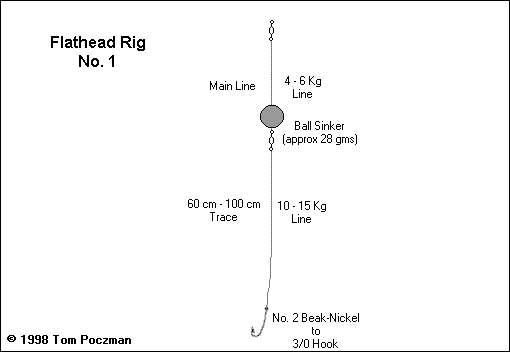Flathead
Introduction
Platycephalidae family
Flathead, as the name suggests, has a broad, flat head, a chunky body which tapers steadily towards the tail, and an extremely large mouth. There are two poisonous spines on either side of the gills, so caution is warranted when handling these fish. They are a bottom dwelling fish, and they prefer to conceal themselves near the edges of weed beds and sand patches, where they ambush their intended targets. They are an extremely quick and agile fish, and do offer a great fight on light tackle, when hooked.
Compared to the eastern states, there are relatively few species of flathead in SA waters. The "Sand" flathead is by far the most common and numerous, with a few "Dusky" flathead out in deeper waters. The "Dusky" flathead is prevalent off the coasts of northern Victoria, New South Wales and southern Queensland, and this species can grow up to one metre in length and weigh up to ten kilos.
The meat itself is much under-rated in its taste and visual appeal. The flesh is tender, white and sweet, and battered or crumbed fillets shallow fried offers the best results to the taste buds. Flathead also freezes extremely well.
The best way to catch flathead is from a boat on the drift. This drift should be slow, so that the fish have time to see the bait as it passes by. Flathead can also be caught in large quantities from the shore. Casting from the beach and slowly retrieving the rig offers the best results.
Flathead also has a very large mouth, and therefore baits should be big. When using fish fillets, shape the bait like a small fish and leave a 2cm tail hanging from the hook. When the fish takes the bait, strike hard as the flathead has a very bony mouth, so sharp hooks are a must !
In Sth Australia, flathead are usually a by-catch of a fishing session on Bream or Whiting and are rarely sought after exclusively. When landed, flathead should be handled with care. The sharp gill plate spines can inflict nasty lacerations. A common and popular way of un-hooking a captured flathead is to lie the fish on a chopping board and drive a small knife thru the top of its head. This serves the dual purpose of killing the fish humanely and rendering it less likely to cause injury during the un-hooking process.
They can be caught at any time of the day. Tides appear to be more critical, particularly in shallow water over sandy flats. The most productive time for fishing flathead is from one hour after low tide up until high tide.
For further information on flathead, have a look at How to Catch Flathead.
Legal Minimum Length
| Current Limit: | 30 cm | [Previous: | No Restrictions] |
Bag Limit
| Current Bag Limit: | 10 per person | [Previous: | No Restrictions] |
| Current Boat Limit: | 30 per boat | [Previous: | No Restrictions] |
Type of Tackle
Use main line between 4 to 6kg with a 60cm monofilament leader three times the thickness of the main line to act as a shock absorber, as well as to counteract abrasions of the line against the sharp spines on the outer extremities of the flathead's gill plates.
A rod around 1.8m to 2.0m is ideal for both jetty and boat fishing.
Hook Selection
No.2 Beak-Nickel "Holdfast" nylon snelled hooks that come pre packed thru to a 3/0 hook size are ideal. The size of the hook used dependant on the size of flathead being caught.
Baits Used
Fish Fillets (Mullet, Mackerel, Yellowtail), Whitebait, Shrimp, Prawns, Pilchards, Cockles, Squid, Beachworms, Octopus
Berley Mix
The simply scatter by hand of any offal, diced pilchards or commercial berley pellets will suffice. The smell generated should bring any flathead around to investigate.
Rigs Used
Rig No. 1
The following rig can be used either off a jetty, or from an anchored boat. This simple running sinker rig is ideal also for catching Bream. Its important to have a heavy trace, as when flathead feels the hook, it instinctively throw its head around quite violently and if a thin, monofilament trace is used and comes into contact with the spines under pressure, a break off will result.

 Fishing Tip : Fishing Tip : |
|
| Why not contact fishSA.com about your Fishing Tip |
|
|